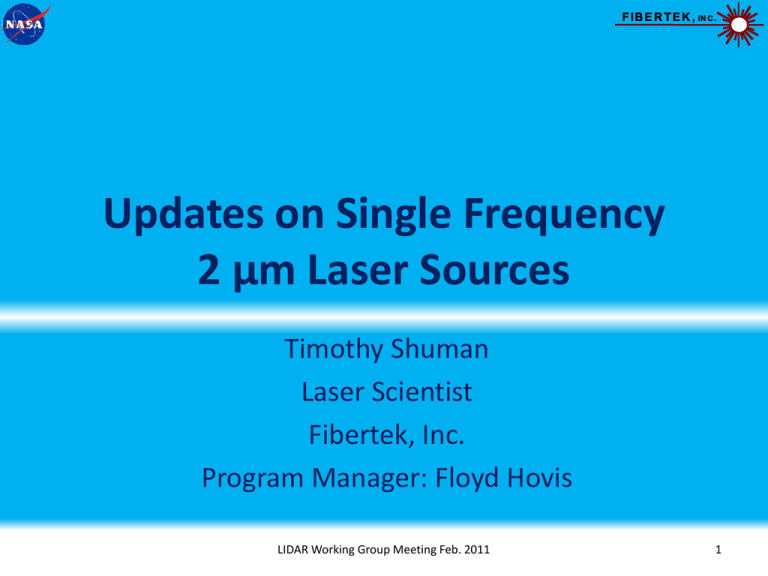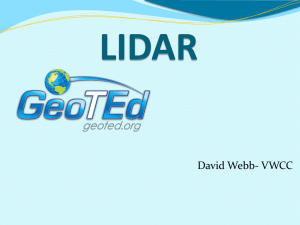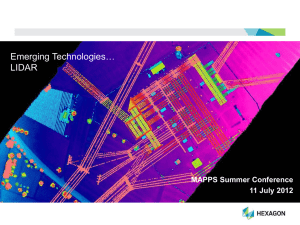Updates on Single Frequency 2 µm Laser Sources
advertisement

F IB E R T E K , IN C . Updates on Single Frequency 2 µm Laser Sources Timothy Shuman Laser Scientist Fibertek, Inc. Program Manager: Floyd Hovis LIDAR Working Group Meeting Feb. 2011 1 F IB E R T E K , IN C . Acknowledgements FIBERTEK NASA LANGLEY RESEARCH CENTER • • • • • • Jirong Yu • Mulugeta Petros • Upendra Singh Kevin Andes Ti Chuang Joel Edelman Joe Rudd Tom Schum LIDAR Working Group Meeting Feb. 2011 2 F IB E R T E K , IN C . Outline • Motivation for 2 µm laser sources • 2 µm Risk Reduction Laser Transmitter (RRLT) – Program overview – Key design features – Latest results • 2 µm single frequency CW seed laser overview • Summary LIDAR Working Group Meeting Feb. 2011 3 F IB E R T E K , IN C . Motivation • Airborne and space-based wind measurements are needed: – Critical to improving global weather forecasting and weather hazard warnings – Important to climate change research • 2 µm sources are used in the coherent channel of hybrid wind systems – Determined the optimum system to perform these measurements • Requires not only hardened high energy pulsed lasers but also hardened CW lasers to seed them for single frequency operation LIDAR Working Group Meeting Feb. 2011 4 F IB E R T E K , IN C . 2 ΜM RISK REDUCTION LASER TRANSMITTER (RRLT) FOR AIRBORNE & SPACE-BASED DOPPLER WIND LIDAR LIDAR Working Group Meeting Feb. 2011 5 F IB E R T E K , IN C . Program Background • NASA, NOAA and the DoD all have been pursuing global wind measurements since the 1970s – A hybrid system utilizing coherent and direct detection is optimum – The coherent channel needs a high energy pulsed 2 µm laser source • NASA LaRC successfully advanced 2 µm laser technology from 20 mJ to 1.2 J per pulse by Dec. 2005 via internal funding • Purpose of this program to build a risk reduction laser incorporating all of LaRC’s lessons learned in an engineered “space-like” breadboard (TRL 6) – Understand laser behavior – Demonstrate the shot lifetime needed for space – Meet the performance required for a hybrid wind LIDAR system • Phase 3 SBIR cost sharing program with funding split between NASA LaRC and Fibertek LIDAR Working Group Meeting Feb. 2011 6 F IB E R T E K , IN C . Performance Targets Parameter Value Pulse Energy >250 mJ Repetition Rate 10 Hz Pulsewidth >200 ns Linewidth Single frequency Beam Quality M2 < 1.2 Diode Current 30% derating from maximum operating current Cooling Conduction cooled gain modules Volume <0.075 m3 Weight <30 kg LIDAR Working Group Meeting Feb. 2011 7 F IB E R T E K , IN C . Design Features • Tm,Ho gain medium – 2 µm emission without nonlinear conversion – Compatible with diode pumping with an absorption peak near 792 nm – Optimum performance at low temperatures • Observed 2X gain in energy at -26°C • MOPA configuration using 3 side-pumped gain modules – Oscillator and 2 amplifiers – 5 sided pumping • 3 m cavity using a multi-fold telescopic resonator • Acousto-optic Q-switch • Injection seeded with a commercially available single frequency source (Lockheed Martin Coherent Technologies Meteor) – The cavity length is dithered via a PZT – Electronics fire the Q-switch when a cavity resonance is detected LIDAR Working Group Meeting Feb. 2011 8 F IB E R T E K , IN C . Laser Concept Laser path (solid) – 3 m Round trip PZT Oscillator Amplifiers Seed path (dashed) Source not shown Isolators Laser bench Installed inside cylindrical housing Coolant lines or heat pipes Bench and housing designed for maximum mechanical strength and stability LIDAR Working Group Meeting Feb. 2011 9 F IB E R T E K , IN C . Laser Bench – Oscillator Configuration Bench Dimensions: 45.5” L x 6.45” W x 2.75” H Volume = 0.13 m3 Oscillator Seed fold mirror Q-Switch Isolator PZT Seed laser fiber output Alignments performed with lockable Risley prisms LIDAR Working Group Meeting Feb. 2011 10 F IB E R T E K , IN C . Pump Module Design Rod held By 5 heat sinks Diode light Coupled into rod Between heat sinks LIDAR Working Group Meeting Feb. 2011 Assembled Oscillator Pump Module 11 F IB E R T E K , IN C . Optimum Performance to Date 1 Hz, 750 µs, 79 A, 5°C 1.9 µs build-up time 250 ns pulsewidth Single Frequency 37” from OC Pulse Energy (100 pulse avg.) Long Pulse Q-Switched 97 mJ 47.5 mJ 49% Q-switching Efficiency 12 F IB E R T E K , IN C . Additional Performance Notes • • • • <3% RMS energy stability ~30% derating from peak current 5°C operating temperature Single frequency determination made from clean profile recorded using a 500 MHz detector and 200 MHz oscilloscope – Longitudinal mode spacing ~50 MHz LIDAR Working Group Meeting Feb. 2011 13 F IB E R T E K , IN C . SINGLE FREQUENCY LASERS FOR SPACE BASED WIND & AEROSOL LIDAR LIDAR Working Group Meeting Feb. 2011 14 F IB E R T E K , IN C . Program Background • Phase 2 NASA SBIR • Two separate CW laser builds: – Multiwavelength seed laser (1064, 532, 355 nm) frequency locked to an iodine cell (using the 532 nm output) to provide a multiwavelength single frequency source • Delivering hardened brassboard laser with a frequency locking module – 2 µm seed laser • Delivering proof of concept hardened breadboard • No frequency control required for this program LIDAR Working Group Meeting Feb. 2011 15 F IB E R T E K , IN C . 2 Micron Seed Laser • Compact Tm,Ho ring laser – Diode pumped • Designed for PZT cavity dithering, as applied on RRLT • Using ruggedized package concepts • Scheduled for completion in June 2011 LIDAR Working Group Meeting Feb. 2011 16 F IB E R T E K , IN C . Summary • Fibertek is advancing the state of the art for multiple classes of 2 micron sources • First, hardened high pulse energy single frequency sources are under development to enable space-based wind measurements using coherent detection techniques • Second, CW lasers suitable for seeding the above high energy pulsed sources are under development • Will allow Fibertek to provide a complete single frequency 2 micron source compatible with airborne and space-based applications LIDAR Working Group Meeting Feb. 2011 17 F IB E R T E K , IN C . Support Equipment Directed Energy Diode Drivers Amplifier (1 of 2) FTS Low Temperature Chiller (On Loan from NASA) Oscillator NEOS Q-Switch Driver Meteor Seed Laser Control & Monitoring Electronics Laser Head Controller LIDAR Working Group Meeting Feb. 2011 18 F IB E R T E K , IN C . Energy & Diode Wavelength vs. Temperature Diodes sitting on absorption peak NOTE: The diode temperature measured is its mounting plate and not the diode submount (isolation required). Actual temperatures may be higher than these measurements and the increased energies due to walking the wavelength onto the peak. LIDAR Working Group Meeting Feb. 2011 19 F IB E R T E K , IN C . Next Steps • Quantify the alignment sensitivity of the current cavity configuration • Quantitatively measure the laser linewidth • Install thermistors on a selection of diodes to track their temperature – Combine with OSA measurements to allow prediction of diode wavelength at any operating temperature • Install a dry box on the laser to allow operation at lower temperatures without the risk of condensation • Begin construction of the amplifier modules LIDAR Working Group Meeting Feb. 2011 20








